I use .net core 3.1.6. There are lots of answer about this and I try all but failed each time. So I create new test MVC project and add authentication.
I try to use a "CurrentUserService" class and get logged user information. However, every each time I get null result.
My startup.cs
public void ConfigureServices(IServiceCollection services) {
services.AddDbContext<ApplicationDbContext>(options =>
options.UseSqlServer(
Configuration.GetConnectionString("DefaultConnection")));
services.AddDefaultIdentity<IdentityUser>(options => options.SignIn.RequireConfirmedAccount = true)
.AddEntityFrameworkStores<ApplicationDbContext>();
services.AddHttpContextAccessor();
services.AddScoped<ICurrentUserService, CurrentUserService>();
services.AddControllersWithViews();
services.AddRazorPages();
}
// This method gets called by the runtime. Use this method to configure the HTTP request pipeline.
public void Configure(IApplicationBuilder app, IWebHostEnvironment env) {
if (env.IsDevelopment()) {
app.UseDeveloperExceptionPage();
app.UseDatabaseErrorPage();
}
else {
app.UseExceptionHandler("/Home/Error");
// The default HSTS value is 30 days. You may want to change this for production scenarios, see https://aka.ms/aspnetcore-hsts.
app.UseHsts();
}
app.UseHttpsRedirection();
app.UseStaticFiles();
app.UseRouting();
app.UseAuthentication();
app.UseAuthorization();
app.UseEndpoints(endpoints => {
endpoints.MapControllerRoute(
name: "default",
pattern: "{controller=Home}/{action=Index}/{id?}");
endpoints.MapRazorPages();
});
}
And my CurrentUserService.cs
public class CurrentUserService : ICurrentUserService {
private IHttpContextAccessor _httpContextAccessor;
public CurrentUserService(IHttpContextAccessor httpContextAccessor) {
_httpContextAccessor = httpContextAccessor;
//I add x for test purpose and there is no user information here.
var x = _httpContextAccessor.HttpContext?.User?.FindFirstValue(ClaimTypes.NameIdentifier);
}
public string UserId {
get {
var userIdClaim = _httpContextAccessor.HttpContext?.User?.FindFirstValue(ClaimTypes.NameIdentifier);
return userIdClaim;
}
}
public bool IsAuthenticated => UserId != null;
}
ICurrentUser.cs
public interface ICurrentUserService {
string UserId { get; }
bool IsAuthenticated { get; }
}
DbContext.cs
public class ApplicationDbContext : IdentityDbContext {
private readonly ICurrentUserService _currentUserService;
public ApplicationDbContext(DbContextOptions<ApplicationDbContext> options)
: base(options) {
}
public ApplicationDbContext(
DbContextOptions<ApplicationDbContext> options,
ICurrentUserService currentUserService)
: base(options) {
_currentUserService = currentUserService;
}
}

